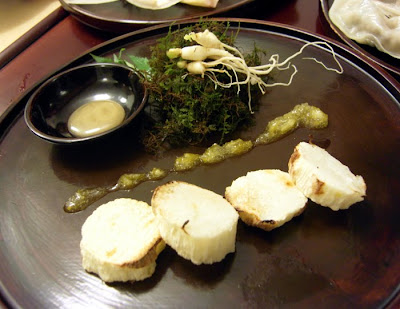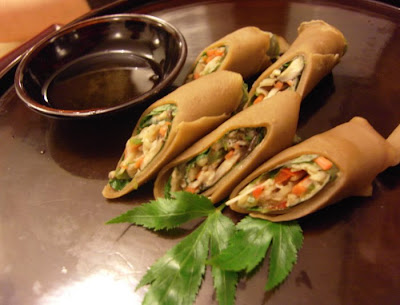What is temple food? It is a loose English translation for seonshik(선식) or "zen food"; food that is consumed while a person is going through Buddhist zen meditation. The food is pure, natural and in most occasions organic, and as Buddhism is against the killing and devouring of animals, 100% vegetarian. Food served in Buddhist temples = temple food.
Okay. So. You're ready to try some temple food but don't want to hike up hills and mountains - where most of the temples are - no matter how strongly your Korean friends emphasize how beautiful those temples are. (Honestly? No matter how hardcore an urbanite you are, they truly are quite beautiful and really worth a trip!)
Fine. Let's say you're stubborn. Lucky for you, there are many temples within the city and you'll be able to find restaurants near those temples that serve vegetarian dishes.
The largest temple food restaurants in Seoul can be found in Insadong, the heart of old Seoul. Jogyesa, the head temple for the Jogye Order of Korean Buddhism is situated there and many related shops and stores can be found across the street from the temple.
The Buddism Cultural Corps for the Jogye Order, "Temple Stay" is also a prominent building in the area, a one-stop place for all things Buddhist. On the 5th floor of the Temple Stay is 'Baru', the temple food restaurant with a modernized twist.
Baru literally means the food bowl of a Buddhist monk. Baru is normally paired with 'gongyang(공양)' - an offering to Buddha - and together they describe a Buddhist's meal. Eating is done with reverence and absolutely nothing is wasted. The portions are meant to be small yet not lacking.
Although a modern day Seoulite may not be able to genuinely recreate a monk's demeanor while approaching meals, it wouldn't be too farfetched to say that eating "slow food" that has gone through much time and devotion does put one in a contemplative, almost zenlike mood.

Simple plain setting. Wooden spoons and chopsticks, unlike the usual metal ones used in most Korean restaurants (and homes.)
 Dried sliced fruit and veggies. These aren't seasoned at all; you get the naturally condensed sweet flavor of the sweet potato, orange, apple and lotus root.
Dried sliced fruit and veggies. These aren't seasoned at all; you get the naturally condensed sweet flavor of the sweet potato, orange, apple and lotus root.
 Cold dongchimi to arouse your appetite. Extra simple, no frills variation.
Cold dongchimi to arouse your appetite. Extra simple, no frills variation. Deodeok salad with yuzu sauce. (We Koreans eat a lot of medicinal roots and herbs.)
Deodeok salad with yuzu sauce. (We Koreans eat a lot of medicinal roots and herbs.) Jeon trio. Jang tteok, mushrooms, squash and mung bean.
Jeon trio. Jang tteok, mushrooms, squash and mung bean. Another trio. Steamed temple mandu, pumpkin tofu, rice wraps.
Another trio. Steamed temple mandu, pumpkin tofu, rice wraps.
Raw wild ginseng and ma (a variety of yam). Served with honey and yuzu sauce.

 Stuffed steamed lotus roots, mushrooms, ginger and spicy pickled peppers on lotus. To be eaten dipped in omija sauce.
Stuffed steamed lotus roots, mushrooms, ginger and spicy pickled peppers on lotus. To be eaten dipped in omija sauce. Mushroom and veggies wrapped in perilla flour crepes.
Mushroom and veggies wrapped in perilla flour crepes. Roasted ginkgo nuts and pine mushrooms with green tea and purified sea salt.
Roasted ginkgo nuts and pine mushrooms with green tea and purified sea salt.
Sweet and sour mushroom and veggies in omija sauce.
 Bean "bulgogi" to be eaten wrapped in steamed myeongi leaves. Apparently the literal English translation for myeongi is 'mountain garlic' which is quite baffling because the Korean encyclopedia specifies that it is "not to be confused with mountain garlic". Yeah, I'm confused, too.
Bean "bulgogi" to be eaten wrapped in steamed myeongi leaves. Apparently the literal English translation for myeongi is 'mountain garlic' which is quite baffling because the Korean encyclopedia specifies that it is "not to be confused with mountain garlic". Yeah, I'm confused, too. Pumpkin, nuts, toran and perilla soup. Extremely thick broth, like a stew.
Pumpkin, nuts, toran and perilla soup. Extremely thick broth, like a stew.(Still not done! Koreans eat a lot. Especially when it comes to traditional cuisine; nothing is too heavy or greasy so naturally you tend to eat more. Or that's the excuse I use.)
Steamed nutty rice lotus wrap. Opening it releases the most wonderful of aromas.


Mu soup. Clear and refreshing.
 Various veggie side dishes, including the ever present kimchi.
Various veggie side dishes, including the ever present kimchi.


 Fresh fruit (sweet persimmon, kiwi, pear) and lotus shaped yanggeng for dessert.
Fresh fruit (sweet persimmon, kiwi, pear) and lotus shaped yanggeng for dessert.

 Various veggie side dishes, including the ever present kimchi.
Various veggie side dishes, including the ever present kimchi.

 Fresh fruit (sweet persimmon, kiwi, pear) and lotus shaped yanggeng for dessert.
Fresh fruit (sweet persimmon, kiwi, pear) and lotus shaped yanggeng for dessert.
There are slight changes made in the menu according to the available vegetables of the season. Herbs eaten in spring and autumn differ a bit and it would be interesting to check out the variety of flavors.
The 'it isn't a meal if there isn't any meat' diners in our group didn't feel the meal was substantial enough, but I enjoyed it fairly well. Light yet hearty, with no heavy aftertaste lingering in your mouth.
The downside for me was that it being a Buddhist establishment, there were't any alcoholic beverages available. I kept thinking how wine or a traditional cheongju would have enhanced the meal so much more. (I also thought, "oooh, how lushtastic of me" but I'm quite sure many others would feel the same way.)
The restaurant space isn't that large and there are only a few chair seating tables, the remaining area (of which I couldn't take a picture due to patrons) is comprised of the traditional 'sitting down on cushions' low tables.
 Reservations are recommended, especially if you're the type that can't sit long in the traditional way without getting leg cramps and have to secure one of the chair tables.
Reservations are recommended, especially if you're the type that can't sit long in the traditional way without getting leg cramps and have to secure one of the chair tables.
 Reservations are recommended, especially if you're the type that can't sit long in the traditional way without getting leg cramps and have to secure one of the chair tables.
Reservations are recommended, especially if you're the type that can't sit long in the traditional way without getting leg cramps and have to secure one of the chair tables.Tel) 02 - 2031 - 2081 or 070 - 8238 - 9561
No homepage for the restaurant but for the building and organization Temple Stay (Korean, English, Japanese and Chinese) :
ttp://www.templestay.com/
ttp://www.templestay.com/





